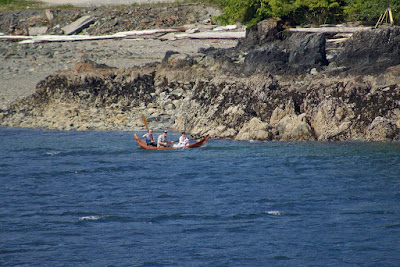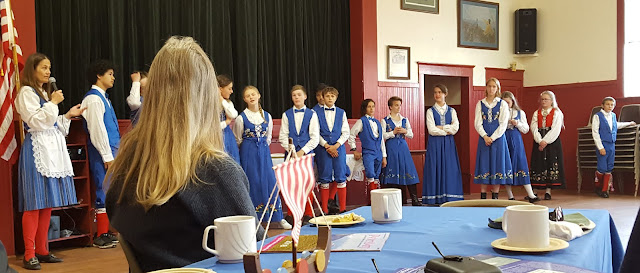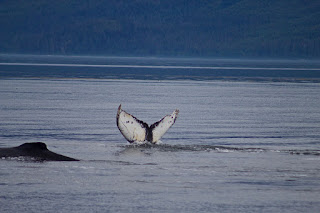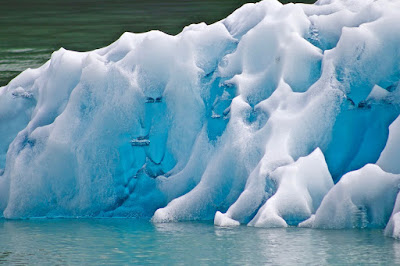If you would like a friendly notice when I post something new, click here, even if you have clicked before.
August 2018 Alaskan Dream
Ten days aboard the Alaskan Dream, cruising through Southeast Alaska, to Sitka, Glacier Bay, Haines, Skagway, Juneau, Tracy Arm, Petersburg, Wrangell, Thorne Bay, Kasaan, Metlakatla, Ketchikan
The small boat Alaskan Dream cruises are beautifully situated between the giant cruise ship entertainment and rough-it exploration. We could be as active as we were inclined to be. Some of us life-jacketted up with a half dozen other guests on the DIB, the stable, motorized inflatable, and are rewarded by getting close to the wildlife.
Although the small size of the Alaskan
Dream allows it to edge up close, too, where the the big cruise
ships can't go. We can almost touch this waterfall from the
foredeck, while keeping one hand on our drinks – such luxury!
Others explore by kayak, paddling as close to the shore as you want to, or skimming over
shallow water to gaze at jellyfish and stones. Lucky me, going
single on my two excursions, I am paired with energetic young crew
members with stories of kayaking out to uninhabited lands to camp
with their high school friends.
Saook Bay with Janae, our cultural naturalist; somewhere off Tracy Arm with Terry, a steward delighted to try kayaking again.
In Sitka many of us hike with Joy –
aptly named – over and under tree roots she has climbed since she
was 11.
When she finishes at Searsey College
(where she and her sister are 4th generation legacies), she will be back
to Alaska to teach and raise a family.
 She and Alex lead us to Mosquito Cove (ha ha – no insects in sight, just two
kinds of slugs. This is the invasive black one on a skunk cabbage
leaf, just like the plants I remember from New England)
She and Alex lead us to Mosquito Cove (ha ha – no insects in sight, just two
kinds of slugs. This is the invasive black one on a skunk cabbage
leaf, just like the plants I remember from New England)Up and down hills through the verdant arctic rainforest.
Surprise! It's Alaska, but green – Southeast is protected by the Alexander Archipelago of hundreds of islands; the temperature range is about 40 – 60 F and it's summer.
 |
| Mosquito Bay |

It's not quite salmonberry season, which
everyone eagerly awaits, and almost at the end of spruce tips.
Later in the trip, a couple of guys get to go fishing with locals Captain Eric knows, and bring back a giant halibut for our dinner. We all watch closely as Garrett, our chef, fileted. Yes, we ate very well, but were not stuffed as I have heard is common on the big ships. Local fish, fresh cookies in the evening in the lounge, chocolates on our pillows.
Imagine this space filled with
chattering guests. With a choice of seating at meals, we get to meet
and talk story with most of the other 30 or so passengers by the end
of the trip. Mostly retired from a variety of jobs - molecular
biology, telephone tech, a couple – a nurse and a veternarian. Mostly
American – Massachusetts, Idaho, California, a couple from Shropshire and another from Australia. Gardening, personal
histories flowing easily into mutual interests.
At most stops, there is time and space
to wander at our own pace, or sit in a local restaurant, or check out
a museum.
In Wrangell, we walk out to the Chief Shakes clan house, built by the Civilian Conservation Corps in the 1930s in the style of the old community houses. Wikipedia has an account of the Tlingit leader's history and lineage at en.wikipedia.org/wiki/Shakes_(Tlingit_leaders).
In Sitka, we walk up to the Raptor
Center, twice, where injured eagles, hawks, owls are healed and released
back to the wild. Since most of the injuries are human-caused, this
seems like payback. Some birds can't be released, and spend their
lives at the Center, as guests and/or educators, like Snowy, and the
still-spirited hawk, Spirit.
We were drawn to adopt Glaucus, the
grumpy horned owl, who was not impressed.

Almost all of us go along on the guided hikes, with Alaskan Dream staff or local guides.
 |
| Muskeg Park outside Petersburg |
Alex, our naturalist, enthusiast, and resource for everything, is so tender, putting that sedge back in the muskeg after she plucked it to show us the detail. We are having no trouble staying on the path – it's a sponge out there, even though stumpy trees are growing out of it.
Everywhere, whether we are gazing across a flat bog, or strolling through Sitka, or cruising, there are those mountains patchy with summer snow.
Sometimes shrouded in fog and cloud,
re-appearing and disappearing
 |
| St. Michael's Cathedral, Sitka |
 |
| Haines at 4:10 p.m. |
 |
| At 6:00 p.m. |
Almost half the permanent population of
Alaska lives in Anchorage, a city of 292,000 people. Living in LA
(4,000,000 of us) we perhaps have an exaggerated sense of what urban
is, but Alaskans take care to characterize their state as something
different than the dense lower 48.
Even in the capitol, Juneau (30,000
residents), we spent most of our time at the Mendenhall Glacier.
Nugget Falls, also coming off the Juneau Ice Fields, puts it all in
perspective. See the tiny guy taking a picture?
At Kasaan, Metlakatla and Bartlett's
Cove, our Haida, Tsimshian, and Tlingit guides spoke honestly to the
range of feelings and responses to Alaska's history of race
relations. On board, a young Huna Tlingit woman spoke from the
heart, recounting the displacement of an old Tlingit community by the
glacier's advance, only to be barred from returning after generations
when the glacier retreated; their homeland is now Glacier National
Park. When I come across her taking private time in one of my sequestered
corners of the Dream singing homecoming to herself and her ancestors,
and feel the bittersweetness, I silently moved to another place to
watch the glacier approach. My family are wanderers, never in one
place for more than a generation and today I feel sad; where would my homeland be?
At Bartlett's Cove, the Tlingit guide
who talks to us in the all-clan house has to stop for a moment to
gather herself, recounting how she is re-learning her culture and
language from her daughters. Her generation call themselves the lost
generation – sent away to
boarding schools which did not teach their history, punished for speaking their own language.

Here in Haida territory, Fred keeps his
distance; and his oh-so-genial sarcasm keeps me at a distance, too,
and I'm mad that he's using his power over us polite tourists to keep
me in this drafty longhouse, when I have a cold coming on, as fair as
the payback may be.
But I am moved to learn that the
Civilian Conservation Corps reconstructed the Naay I'waans Whale House, in the
30s, and created the totem park with poles from Old Kasaan.

Coming in to Kasaan, we see a tiny boat riding the waves paddled by a young man, with his wife and 2 month old baby, and small energetic white dog. Both the baby and the canoe are on their first trip on the water. What a privilege to be welcomed to witness that!

Stormy, the carver, has already made this smaller canoe, which we passed as we disembarked.
Captain Eric was off the boat before us, greeting his friends. I know we'll be long returned to our usual lives, but I'll still want to know if Eric does crew on the planned 18 footer on a voyage to Hawaii!
The bit of Stormy's explanation that
catches my attention is how fire and water and steam are used to
shape a canoe – char and scrape out a cypress log to hollow it,
then fill it with water and hot stones to soften the sides enough to
push them into that distinctive flared shape.
Stormy is also completing a totem pole
for the village, in a communally discerned design that tells its
history, incorporating past, present and future and all the groups
living in the community. We
had a snack in the Totem Trail Cafe, which also serves as the community center. The Organized Village of Kasaan is a federally recognized tribe, a lively Alaskan
community of some 50 people.
At Metlakatla, Sitka and Juneau,
Tsimshian, Haida and Tlingit Alaskans fill the community clan
houses with drums and dance, at which we are welcomed - at Metlatka
even invited to join our Tsimshian hosts, all levels of grace okay.
In the Norwegian fishing community at
Petersburg, in the Sons of Norway Hall, young dancers in the Mitkof
Dance Troupe, wearing the highly valued dresses and suits that are passed
down and re-fitted to each new dancer, perform their European line
and square dances with skill and joy, and feed us
traditional Norwegian pastries, too.
If you yearn for details of the bunad
costumes, www.runnstitch.blogspot.com has lots from an annual bunad
festival. Online searching revealed that the dance troupe does
disco, too.
I feel comfortable hanging out in the working town Wrangell, detouring for a half hour to admire the giant cranes and forklifts in the shipyard.

 We get three tickets for the annual raffle that raises
money for a lavish Fourth of July celebration (we did not win, but
I'd love to come back for the event). We get our tickets by supporting one of the
contestants for King by ordering a haystack (Fritos, beans, and
cheese – yum), cheesburger and root beer float from their stand
downtown,
We get three tickets for the annual raffle that raises
money for a lavish Fourth of July celebration (we did not win, but
I'd love to come back for the event). We get our tickets by supporting one of the
contestants for King by ordering a haystack (Fritos, beans, and
cheese – yum), cheesburger and root beer float from their stand
downtown,
In Thorne Bay, we get a tour of the
library, now housed in a trailer, and chat with the mayor, out
walking his son's amiable beagle. The community was towed here from its first site in 1961. Yes, really. Logging camps were built on spruce floats, and towed to each new site. We passed some individual floating camps, though the logging boom is past and Thorne Bay is mostly retired folks.
Skagway is cold and touristy, and we
wonder if we are doomed to sitting out of the wind in a coffee shop
before our train ride.
 |
| The Arctic Brotherhood Hall, 1899 |
But another passenger joins us in a
quilting shop bursting with fabrics that range from traditional
raven and bear designs to cute moose patterns. Now what am I going
to do with the Raven pattern, suitable for applique, which I
do not do?
Artistry is everywhere on this trip.
At the Sheldon Jackson Museum in Sitka, I chat for a long time
with the visiting artist, Chloe French, Tlingit/Danish/Irish, of the
Eagle moiety and Tsaagweidi clan. I've now heard several versions of
Raven Stealing the Sun, and love seeing and hearing Chloe's. In
words and fabric she tells the moment people are half way between
animal and human. After they refuse three times to ferry him
across a river, hot-tempered Raven opens the bag in which he is
carrying the stolen sun and flings it into the sky, and turns all the
selfish, foolish people into the animals whose skins they were
wearing.
At the dock in Thorne Bay, I chat
with two artisans as I choose earrings and a pendant; one had come
from across Prince of Wales Island for the day with her earrings and
pins made with soft leather and beads, the other lives with her
husband on the Lillian Rose – which is outfitted with all her equipment for
shaping and making jewelry from ancient fossil coral and silver. One woman has a
website, and was surprised that I did not; the other not even a
business card.

Of course, these also appealed to me!
 |
| Yeltatzie Salmon, made by Terry Pyles in honor of the Native carver whose wooden salmon was here in Ketchikan for years |
 |
| Greeter at Alaskan Dream Visitors Center, Ketchikan |
At Sealaska and the Sheldon Jackson
Museum, in and on the clan houses, and outdoors in every community we
revel in the beauty and skill of tribal artistry, as we are
introduced to its place in clan and tribal life.
 |

 | ||||||||||||||||
| Kasaan |
 | |||||||||||||||||||||||
 Bartlett's Cove tribal house, constructed in 2016, joins all four Huna Tlingit clans. At www.nps.gov, look for "Huna Tribal House" for an account of this reconciliation project.
Bartlett's Cove tribal house, constructed in 2016, joins all four Huna Tlingit clans. At www.nps.gov, look for "Huna Tribal House" for an account of this reconciliation project.
Skagway shows us another face of
Alaska's past from the comfort of the White Pass and Yukon Railroad
car.
We look down at the narrow trail where thousands of hopeful miners lugged their ton of supplies and equipment on the way to the Klondike gold fields, still hundreds of miles away.

We look down at the narrow trail where thousands of hopeful miners lugged their ton of supplies and equipment on the way to the Klondike gold fields, still hundreds of miles away.

As we motor gently from town to town -
Lynn Canal, Icy Strait, Frederick Sound, Clarence and Chatham
Straits, Stephens Passage, Tracy Arm
under us an unseen community cruises as
well.
When the captain somehow intuits, or is passing familiar whale locations, he slows the Dream and guests hustle out to the fore deck, cameras at hand.

Very cool, of course, is a dramatic flip completely into the air, which we get to see once to the collective gasps of everyone on board
or the co-operative “bubble
netting”. Mama humpback circles a school of krill with a spiraling
ring of bubbles until her companions surge up through the compressed
mass of food, scooping up mouthfulls – and those are Some Mouths!
In the quiet coves and harbors, otters
often float improbably on their backs. Out on the wilder waters, a couple of killer whales skim
alongside us one day, and Alex catches this amazing photo.
We slow by Russell Island, too, to watch the sea lions lounging and arguing and humping gracelessly over the rocks toward the ocean, where they are transformed into sleek smooth water beings.
At Orca Point Lodge, near Juneau, Sam,
an enthusiastic marine biologist, gathers sea creatures every day to
inhabit a tide pool touch tank, and we can get in close to the
complex, beautiful community under the sea surface. She loves
chitons the most – the oldest living creature on earth.
So long, thanks for sharing your water world with us


Cameras at the alert, guests caught these photos of other Alaskan life: a porcupine at Bartlett's Cove, who waddled across the path behind us and up a tree before he looked back


Cameras at the alert, guests caught these photos of other Alaskan life: a porcupine at Bartlett's Cove, who waddled across the path behind us and up a tree before he looked back
 |
| Showy puffins |
Gulls and cormorants are too familiar
for us to document in pictures. Eagles are everywhere, perched in
towns and in the wild with a kind of arrogant indifference.
By the way, moose don't come down to
the tourist areas in Southeast – this was as close as we got
Janae slowed down to meet and cuddle Arcticat as we
strolled toward a beach of ancient petroglyphs, including this one of
a very recognizable whale.
The Alaska State Library lists hundreds of named glaciers in Alaska, and the US Geological Survey guesses that there are 100,000 altogether - ice rivers constantly advancing and retreating.
Here we are, calmly motoring up to an unmelted mountain of ice - Margerie Glacier. It looks so still from a distance, epochal.
You want to know how big they are?
This is one single cruise ship that
we saw in Ketchikan; if you look closely, our Alaskan Dream is the
little white ship under the line of orange lifeboats:
And here is a cruise ship next to
Marjorie Glacier. OK, it's not one of the most hugest cruise ships –
7 or 8 decks, but maybe not as long as the Holland Lines one above.
Yes, I wanted to see a glacier
“calving”, breaking off and thundering into the melted water at
its edge. But it's satisfying enough to learn that the light is
refracted through the ice into intense blues,
and to witness the inexorable, geologically slow power that scrapes solid rock up to a mile high


Southeast Alaska is water in all its
forms.
Hard as fractured ice,
soft as snow and rain,
light as fog and cloud,

Hard as fractured ice,
soft as snow and rain,
light as fog and cloud,


filling moss with
moisture, drunk up by trees and plants,
floating boats, making way for whales.
floating boats, making way for whales.
I am so contented here hanging over the
rail or sitting back in a chair in a quiet corner on the middle deck
on the Dream, lost in the patterns of living water, the land moving
by, rocks and trees, the clouds/fog/mist; images I will take home in
my head to mine for serenity, as well in photographs to share.



On the ship, I can be social, too,
sharing the top deck with other guests, a good place to take in the
variety of Alaskan human life as we approach another town.
Or hide
out in our cabin, glad to have held out for the luxury of the Vista
View above the foredeck. Waking up in the night or early morning to
indistinct shapes of islands and horizon. Front row seat for whale
watching.
Ten days of restoring, energizing, enlarging.
 |
| Capt. Eric, Janae, Amy, Shannon |
 |
| Alex |
 | |
| Brent, Jonathan F, Lee, Vincent, Jonathan N, Billy, Nick |
Subscribe to:
Posts (Atom)
































































































